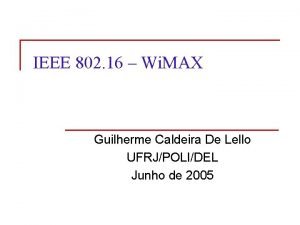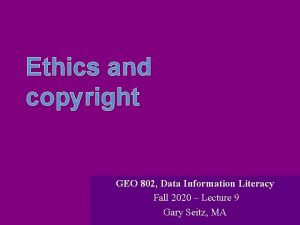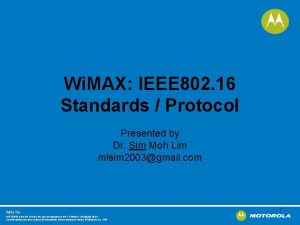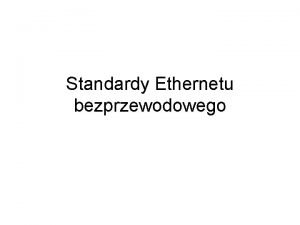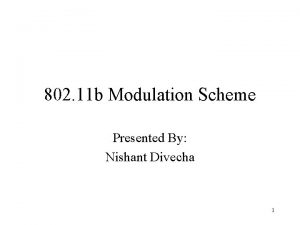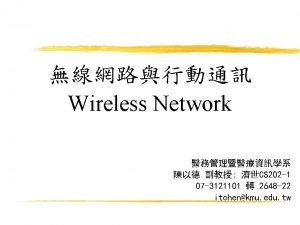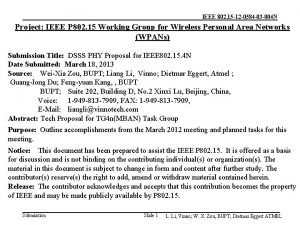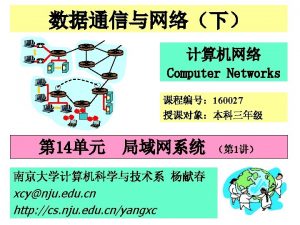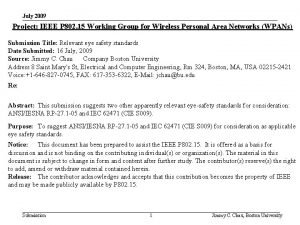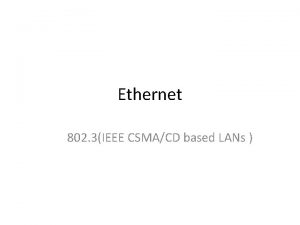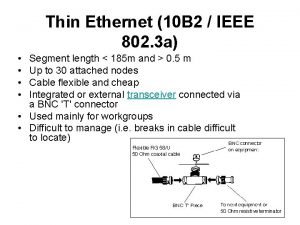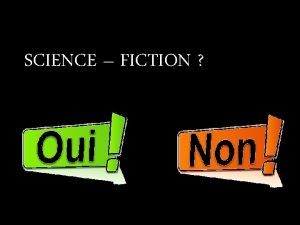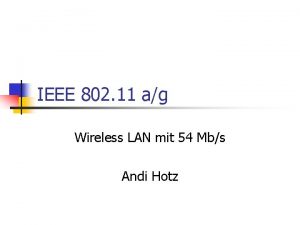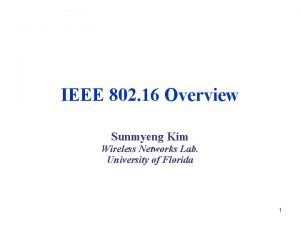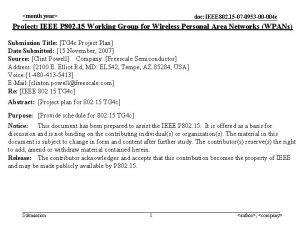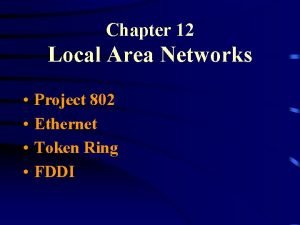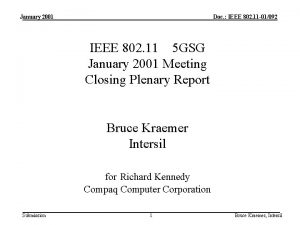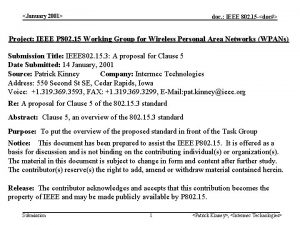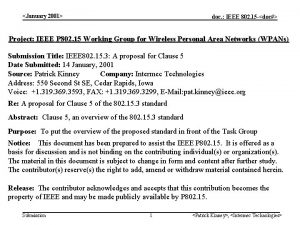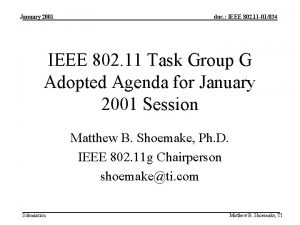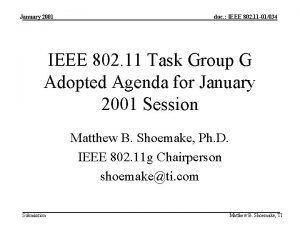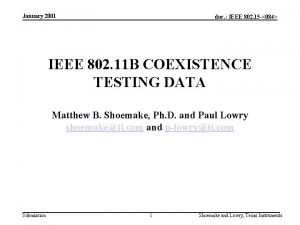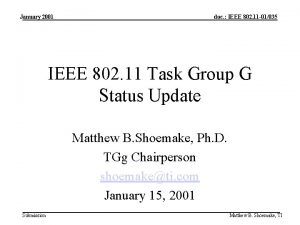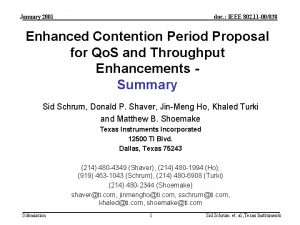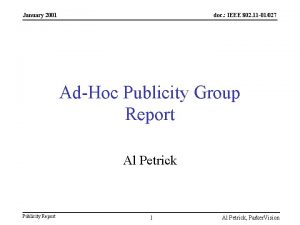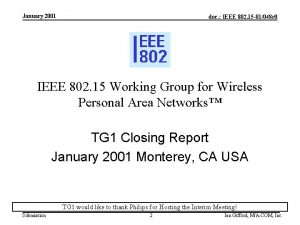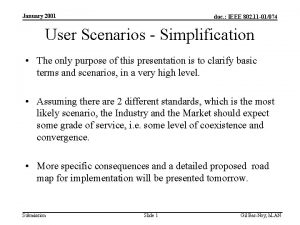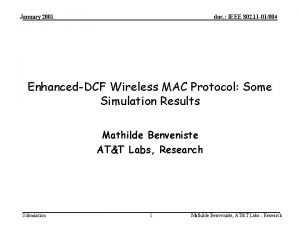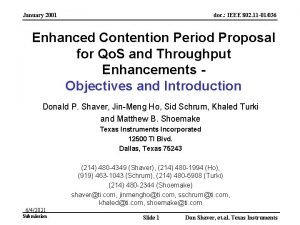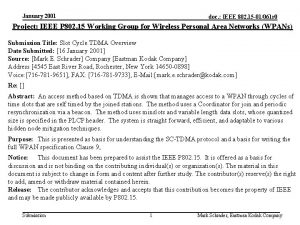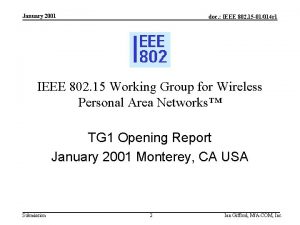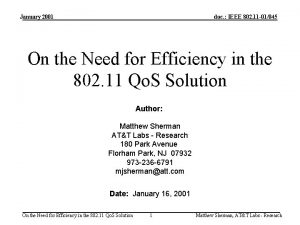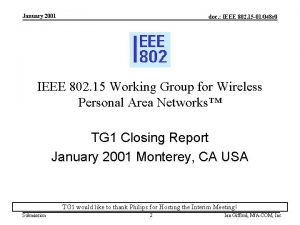January 2001 doc IEEE 802 15 01092 r





























- Slides: 29

January 2001 doc. : IEEE 802. 15 -01/092 r 1 Project: IEEE P 802. 15 Working Group for Wireless Personal Area Networks (WPANs) Submission Title: Non-Collaborative Mechanisms for the Enhancement of Coexistence Performance Date Submitted: January 18, 2001 Source: Oren Eliezer Company: Texas Instruments Israel Address: POB 5133, Kfar-Saba 44150, Israel Phone: +972 -9 -7476962, Fax: +972 -9 -7430951, E-Mail: Oren. E@ti. com Re: Non-collaborative means for enhancing coexistence performance of FHSS systems Abstract: This presentation discusses and demonstrates the implications of improper power control. It stresses that coexistence scenarios tend to be asymmetrical, in the sense that the two ends of a communication system suffer differently and therefore should be treated differently. It also suggests selecting specific properties for the hopping sequence that could potentially reduce the interference caused by the FHSS system (as well as the interference suffered by it). Purpose: The purpose of this is to operate FHSS systems with transmission parameters and coexistence mechanisms that would minimize the interference caused by them, as well as minimize the interference they suffer. Notice: This document has been prepared to assist the IEEE P 802. 15. It is offered as a basis for discussion and is not binding on the contributing individual(s) or organization(s). The material in this document is subject to change in form and content after further study. The contributor(s) reserve(s) the right to add, amend or withdraw material contained herein. Release: The contributor acknowledges and accepts that this contribution becomes the property of IEEE and may be made publicly available by P 802. 15. Submission 1 Oren Eliezer, Texas Instruments

January 2001 doc. : IEEE 802. 15 -01/092 r 1 IEEE 802. 15 TG 2 Non-Collaborative Mechanisms for the Enhancement of Coexistence Performance Monterey January 18, 2001 Oren Eliezer Texas Instruments Israel Oren. E@ti. com Submission 2 Oren Eliezer, Texas Instruments

January 2001 doc. : IEEE 802. 15 -01/092 r 1 Outline • The asymmetry of interfered links • Coexistence mechanisms should be application based • Motivation for TX power control • Example of coexistence scenario (numbers) • Principles of transmission power control • Properties of the hopping sequence and their impact on system adaptability and performance • FHSS related ideas for enhanced coexistence performance • Summary and Conclusions Submission 3 Oren Eliezer, Texas Instruments

January 2001 doc. : IEEE 802. 15 -01/092 r 1 Distinction between Applications in Terms of Extent and Symmetry of Interference Impact (1/2) • Extended range voice connections (cordless phone) sensitive to loss of packets, can tolerate high BER. Asymmetric (due to location, not application) • Short range voice connections (headset, in-room cordless extension) - same as above but has more robust link. Could be symmetric in reception of interference. • Audio (MP 3 player or speakers) - very sensitive to errors. Very asymmetric susceptibility to interference. Submission 4 Oren Eliezer, Texas Instruments

January 2001 doc. : IEEE 802. 15 -01/092 r 1 Distinction between Applications in Terms of Extent and Symmetry of Interference Impact (2/2) • Video (remote display, videoconferencing) - sensitive to uniformly distributed errors more than to bursts of errors. Symmetric if bi-directional and operating at short distances (otherwise not). • Short distance short-term wireless connections (PDA synchronization, short file transfer between notebook PCs) - can tolerate significant throughput degradations. Asymmetric, since data flow is typically heavier in one direction. • Networking - (in meeting room, offices or home) tolerant to interference as long as latencies do not become unbearable. Asymmetric due to relative locations. Submission 5 Oren Eliezer, Texas Instruments

January 2001 doc. : IEEE 802. 15 -01/092 r 1 Interfered Links Are Asymmetric ! • Two ends of an interfered system may suffer different performance degradations, depending on relative location (especially at extended ranges). • The performance degradation is asymmetric also due to application properties (example: the asymmetric amount and purpose of data flow in a web-browser or an MP 3 player). • Different treatment may be needed for each end (e. g. power increase, or packet fragmentation in one direction only) • Even non-interfered links could be asymmetric due to different receiver sensitivities and transmission power levels at the two ends. Submission 6 Oren Eliezer, Texas Instruments

January 2001 doc. : IEEE 802. 15 -01/092 r 1 Motivation for Power Control • Power control is intended primarily to reduce interference to other systems • A reduction in a system’s TX power, could sometimes indirectly enhance its performance • Another advantage of reduced TX power could be reduction in current consumption (true only for higher levels of power and in battery operated devices) Submission 7 Oren Eliezer, Texas Instruments

January 2001 doc. : IEEE 802. 15 -01/092 r 1 Example of Scenario where Reduced Power Helps both Systems Involved in a Coexistence Scenario (5 slides) Submission 8 Oren Eliezer, Texas Instruments

January 2001 doc. : IEEE 802. 15 -01/092 r 1 (1) A at its high power, B at its low power Interference of A to B is not tolerated by B: system B, device B 2 system B, device B 1 5 m PTX = 10 d. Bm -44 d. Bm PRX(min)= -75 d. Bm PTX (max)= 20 d. Bm C/I = -3 d. B -43 d. Bm -41 d. Bm 2. 5 m PTX = 5 d. Bm 2 m PTX = 5 d. Bm 0. 5 m PRX(min)= -75 d. Bm PTX (max)= 5 d. Bm system A, device A 2 is assumed to be a remote web browser -29 d. Bm system A, device A 1 Submission 9 Oren Eliezer, Texas Instruments

January 2001 doc. : IEEE 802. 15 -01/092 r 1 (2) A at its high power, B at its low power Interference of B to A is low, but B initiates increase: system B, device B 2 system B, device B 1 5 m PTX = 10 d. Bm -44 d. Bm PRX(min)= -75 d. Bm B 1 initiates power increase C/I = -3 d. B PTX = 10 d. Bm 2. 5 m -38 d. Bm 2 m -36 d. Bm system A, device A 2 C/IA 1 = 7 d. B PRX(min)= -75 d. Bm PTX = 5 d. Bm 0. 5 m -29 d. Bm C/IA 2 = 9 d. B system A, device A 1 Submission 10 Oren Eliezer, Texas Instruments

January 2001 doc. : IEEE 802. 15 -01/092 r 1 (3) A at its high power, B at its high power Interference of B to A increases and A is jammed: system B, device B 2 system B, device B 1 5 m PTX = 20 d. Bm -34 d. Bm PRX(min)= -75 d. Bm C/I = 7 d. B PTX = 20 d. Bm 2. 5 m -28 d. Bm 2 m -26 d. Bm C/IA 1 = -3 d. B 0. 5 m PRX(min)= -75 d. Bm -29 d. Bm PTX = 5 d. Bm system A, device A 2 C/IA 2 = -1 d. B system A suffers desensitization !!! system A, device A 1 Submission 11 Oren Eliezer, Texas Instruments

January 2001 doc. : IEEE 802. 15 -01/092 r 1 (4) But if A uses low power, B will too Interference of A to B is very low: system B, device B 2 system B, device B 1 5 m PTX = 10 d. Bm -44 d. Bm PRX(min)= -75 d. Bm C/I = 12 d. B B will remain at low power (10 d. Bm) -58 d. Bm -56 d. Bm 2. 5 m PTX = -10 d. Bm 2 m system A, device A 2 PTX = -10 d. Bm PRX(min)= -75 d. Bm 0. 5 m -44 d. Bm system A, device A 1 Submission 12 Oren Eliezer, Texas Instruments

January 2001 doc. : IEEE 802. 15 -01/092 r 1 (5) if A uses low power, B does too Interference of B to A could be tolerable: system B, device B 2 system B, device B 1 5 m PTX = 10 d. Bm -44 d. Bm PRX(min)= -75 d. Bm C/I = 12 d. B PTX = 10 d. Bm 2. 5 m -38 d. Bm 2 m -36 d. Bm C/IA 1 = -8 d. B PRX(min)= -75 d. Bm 0. 5 m -44 d. Bm system A, device A 2 C/IA 2 = -6 d. B Only occupied frequencies are blocked system A, device A 1 Submission PTX = -10 d. Bm 13 Oren Eliezer, Texas Instruments

January 2001 doc. : IEEE 802. 15 -01/092 r 1 Conclusions from Example (1/2) • Some realistic scenarios could be worse than in the example (depending on power levels, locations and behaviors of systems involved). • Non-linear effects must also be considered • Impact of interference is not only a function of the relative level of interference (C/I), but also dependent upon the absolute value of it. • High level of interference at receiver front end could cause desensitization in entire band. The interfered receiver also becomes more likely to suffer third order intermodulation products (created with additional signals). Submission 14 Oren Eliezer, Texas Instruments

January 2001 doc. : IEEE 802. 15 -01/092 r 1 Conclusions from Example (2/2) • Higher transmission power does not always improve the coexistence performance between the systems involved! • Higher transmission power can potentially increase the level of interference to other systems, who might not even be sensed by the systems A and B we have examined. • Power control algorithms must consider the possibility of other systems being interfered and also the possible aggravation of the situation, and hence must not increase power hastily. Submission 15 Oren Eliezer, Texas Instruments

January 2001 doc. : IEEE 802. 15 -01/092 r 1 Principles of Transmission Power Control (4 slides) Submission 16 Oren Eliezer, Texas Instruments

January 2001 doc. : IEEE 802. 15 -01/092 r 1 (1) When can TX Power be Increased? • TX power may be increased to compensate for propagation losses, but might do a disservice in combating interference. • Power increase should be considered only when data integrity is unacceptable (application dependent, e. g. voice quality in a voice connection). • Reason for performance degradation must be determined prior to power increase decision (interference or propagation losses) Submission 17 Oren Eliezer, Texas Instruments

January 2001 doc. : IEEE 802. 15 -01/092 r 1 (2) Assessment of Interference Levels • When RSSI measurements show a relatively high level of reception for the desired signal (significantly above threshold) power may be reduced. • When RSSI is low, errors could be a result of AWGN. When RSSI is high, errors may be assumed to be the result of interference. • During reception, the presence of interference may be determined through a combined reading of RSSI and data integrity indications (payload BER when coding is used, header integrity, CRC… but obtaining reliable statistics based on these could take time) Submission 18 Oren Eliezer, Texas Instruments

January 2001 doc. : IEEE 802. 15 -01/092 r 1 (3) Assessment of Interference • If RSSI information can be available in the absence of the desired transmission, it can provide a measure of interference level (possible in synchronous systems, or when the interfering signal can be demodulated and identified). • Assessing the channel conditions (propagation losses and interference characteristics) could be quite complex but is rewarding. . . Submission 19 Oren Eliezer, Texas Instruments

January 2001 doc. : IEEE 802. 15 -01/092 r 1 (4) The Levels of Power to be Used • Transmitters should be able to emit at levels as low as -10 d. Bm (strong enough for short range data connections) • High levels, such as 20 d. Bm, or possibly 30 d. Bm, would be used only when necessary to ensure stable reception in conditions of excessive propagation losses, but not to overcome interference. Submission 20 Oren Eliezer, Texas Instruments

January 2001 doc. : IEEE 802. 15 -01/092 r 1 Ideas for Enhanced Non-collaborative Coexistence Performance through Frequency Reuse/Separation Submission 21 Oren Eliezer, Texas Instruments

January 2001 doc. : IEEE 802. 15 -01/092 r 1 Properties of the Hopping Sequence and Their Impact on System Adaptability and Performance (2 slides) Submission 22 Oren Eliezer, Texas Instruments

January 2001 doc. : IEEE 802. 15 -01/092 r 1 Number of Hopping Channels • Effective frequency diversity (in terms of multipath fading) is achieved once the hopping channels are distributed within a sufficiently wide band compared with the coherence bandwidth. • Correlation is likely to be lower at greater frequency distances. • Diversity in terms of interference is a function of the BW of the interferer. • But the number of hopping channels has nothing to do with all that! So why use a large number of channels and contaminate a wider bandwidth? • European and Japanese regulations do not require that! • A lower number of hopping channels enables more adaptability to interference and also reduction of potential interference! Submission 23 Oren Eliezer, Texas Instruments

January 2001 doc. : IEEE 802. 15 -01/092 r 1 Randomness/Length of Hopping Sequence • FCC requires the hopping pattern to be of random nature. There is no requirement regarding the length (period) of the sequence. • If security is of interest (military? ), a longer sequence has the advantage of being more difficult to track (eavesdropping), but do we need that? • When a low number of hopping channels is used and the sequence length is equal to it (e. g. 20), receiver sequence phase acquisition may be based on listening to a single channel for a duration equal to the sequence period. In case of acquisition failure (timeout reached before detecting valid packet), any other channel of the sequence may be used for the next acquisition attempt. Fast and simple! • In Bluetooth, it is a lot more complex to establish connection. . . Submission 24 Oren Eliezer, Texas Instruments

January 2001 doc. : IEEE 802. 15 -01/092 r 1 FHSS Related Ideas for Enhanced Coexistence Performance (2 slides) Submission 25 Oren Eliezer, Texas Instruments

January 2001 doc. : IEEE 802. 15 -01/092 r 1 Transmission Power Control Related Ideas • We wish to enhance both the performance of the FHSS system and that of the interfered “victim” (DSSS, FHSS or whatever other user of the band). • Transmission power, in general, must be reduced to the minimal value necessary to support acceptable performance (on a nonsymmetrical, application-related basis). • Use the clearest channels so as not be interfered and not interfere with others (adaptive frequency hopping). • Adjust transmission power per hopping channel. A frequency hopping transmitter that supports power control would have no problem doing so on a channel basis (in terms of response time) - a software issue only! Submission 26 Oren Eliezer, Texas Instruments

January 2001 doc. : IEEE 802. 15 -01/092 r 1 Frequency-Organization Related Ideas • Grouping frequencies into segments and treating them such could help since they are typically correlated in terms of multipath fading and interference. A channel might not be detected as a bad one when the adjacent one is, but could be marginal and also has a higher potential of creating interference. • Using a shorter hopping sequence has only advantages: – The system using it will have an easier time managing it (conveying frequency replacement information between all units, resynchronization in case of lost connection, etc. ) – The coexisting systems will more easily detect and track the interference caused by such system, and adapt accordingly, if they have such capability. Submission 27 Oren Eliezer, Texas Instruments

January 2001 doc. : IEEE 802. 15 -01/092 r 1 Summary and Conclusions (1/2) • Performance of the frequency hopping system: – In general, frequency hoppers can be very effective in handling the multipath fading typically found in indoor environments, and are also effective in mitigating the effects of interference. – This can be further enhanced through a wiser choice of system parameters (TX power, lower number of hopping channels, channelgrouping, and shorter length of hopping sequence) ! • Performance of the interfered system (victim of the hopper): – Frequency hoppers can be brutal interferers, which are difficult to avoid, and can potentially cause significant degradation to the interfered system. – The interference caused by frequency hoppers can be reduced by minimizing their TX power and making a wise choice of their other parameters (as listed above). Submission 28 Oren Eliezer, Texas Instruments

January 2001 doc. : IEEE 802. 15 -01/092 r 1 Summary and Conclusions (2/2) • Theoretical dynamic optimization of the hopping sequence, as well as practical realization of it, are left for future discussion. • Reliable spectral occupancy assessment is important, and practical realizations for this are worth further investigation and design efforts. Submission 29 Oren Eliezer, Texas Instruments
 Bridges from 802.x to 802.y
Bridges from 802.x to 802.y Bridges from 802.x to 802.y
Bridges from 802.x to 802.y Ieee 802 3 compliance
Ieee 802 3 compliance Ieee802.22
Ieee802.22 Arquitetura ieee 802
Arquitetura ieee 802 Estandares ieee 802
Estandares ieee 802 Ieee 802 standard
Ieee 802 standard 802 15
802 15 802 ieee
802 ieee Ieee 802
Ieee 802 Ieee 802 family
Ieee 802 family 802 16
802 16 Geo 802
Geo 802 802 16
802 16 Standardy 802
Standardy 802 802 11
802 11 802 5
802 5 802 family
802 family 802 15
802 15 802 protocols
802 protocols Sybex ccna
Sybex ccna 09 802 0561
09 802 0561 Ethernet 802
Ethernet 802 802-3-ethernet
802-3-ethernet Lan 701
Lan 701 Ssin-802
Ssin-802 Wireless lan 802
Wireless lan 802 Modulation coding scheme
Modulation coding scheme 802 15
802 15 802*12
802*12











